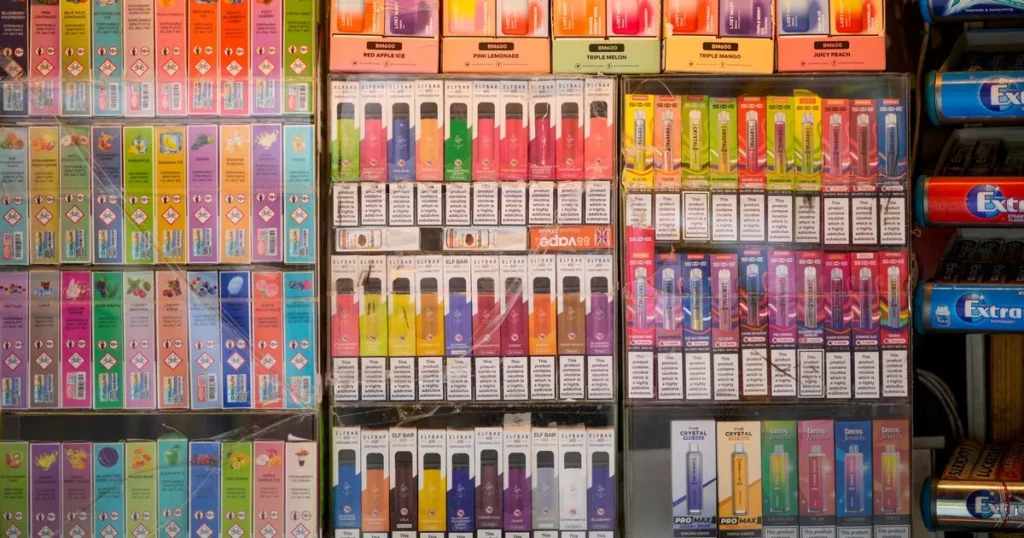
Following our submission sent to the Department of the Environment, Climate and Communications in Response to the Department’s Public Consultation on Disposable Vaping Devices, we wanted to follow up with an article for our blog to further emphasise the issue.
In a world where convenience often takes centre stage, a modern trend has emerged at the crossroads of ease and environmental consciousness. Disposable vaping devices (DVDs), the sleek and user-friendly nicotine delivery devices, have surged in popularity, capturing the attention of a fast-paced society. These compact alternatives to traditional vaping methods offer undeniable ease of use, catering to both vaping veterans and newcomers seeking a hassle-free experience.
Yet, as we embrace the convenience that disposable vapes provide, we’re faced with a stark reality: their convenience comes at an environmental and health cost. The very attributes that make them appealing—disposability and low maintenance—also contribute to their negative impact on our planet and their appeal to children and teens.
This blog takes a comprehensive look at the dichotomy of disposable vapes. We’ll examine the allure of their on-the-go nature, their diverse flavour options and we won’t shy away from the other side of the coin—the detrimental effects of their widespread use on our environment, the appeal they have for children and teens and the impacts they have on our health. Join us as we navigate the landscape of disposable vapes, exploring the convenience that drives their demand and the urgent need to address their ecological repercussions.
Understanding the Composition of Disposable Vapes
One of the issues associated with disposable vapes revolves around their composition — a fusion of diverse materials that forms a composite structure. This amalgamation presents a host of challenges, particularly in terms of their recyclability. Our team at ZWAI, in our extensive 2022 analysis of pharmaceutical blister packages, underscored this very concern. We shed light on the wasteful aspect of such packaging practices, stressing that the presence of greener alternatives demands attention rather than dismissal. This is echoed in the realm of disposable vapes, where their intricate composition exacerbates their wastefulness. In the face of the pressing environmental crisis, the imperative arises to eliminate composite materials like disposable vapes from circulation, especially when their rechargeable counterparts already exist. As Dr. Catherine Gemmell, the Scotland Conservation Officer at the Marine Conservation Society, astutely emphasised,
“In a time demanding a shift towards reuse, the adoption of disposable options signifies a regressive step.” (1)
These devices typically comprise a mix of metals, plastics, batteries, and electronic components, often bonded together through adhesives or other means. This intricate fusion of materials makes it difficult to separate and recycle them effectively. As a result, when disposed of, these devices contribute to electronic waste (e-waste) accumulation, which can lead to soil and water contamination, as well as potential health hazards from toxic substances leaching into the environment. The single-use nature and inability to properly recycle or decompose these composite materials hinders efforts to reduce waste and promote sustainable practices, meaning they don’t belong in the realm of the circular economy.
Health Impacts of Vaping
The long term health impacts of vaping are currently still ambiguous. As Dr Paul Kavangh, who leads the HSE Public Health Medicine Lead with the Tobacco Free Ireland Programme, highlighted in an article by the Irish examiner,
“People often ask us what we think about using an e-cigarette or vaping as a way to help them stop smoking. Our advice is that the best thing you can do for your health is not to smoke or vape. There is no certainty at this point that e-cigarettes support people to quit and we have questions about their safety profile. If someone is wondering about quitting with an e-cigarette or vape, the best advice I would offer is that they would discuss the option of using licensed NRT (nicotine replacement therapy) to help with cravings and nicotine withdrawal with stop smoking advisor.”
An article published by the Lancet in 2022 entitled “Chemical Elements, Flavor Chemicals, and Nicotine in Unused and Used Electronic Cigarettes Aged 5–10 Years and Effects of pH” highlights some health concerns which should not be ignored. The study analysed 181 flavours of “vape juice” and found that every sample contained elements/metals, some of which (selenium, aluminum, tin, arsenic, chromium, lead, nickel, zinc, copper, manganese) are present before use and are known to be harmful to human health (2). Every sample that was analysed contained hydroxyacetone which is a combustible material, and the long term health effects of this chemical have not yet been studied. Hydroxyacetone is a propanone, i.e., acetone in which one of the methyl hydrogens is replaced by a hydroxy group. It has a role as a human metabolite, an Escherichia coli metabolite and a mouse metabolite. It is a member of propanones, a methyl ketone, a primary alcohol and a primary alpha-hydroxy ketone. It is functionally related to an acetone and has been widely used in the cleaning industry, as a food additive and a flavouring agent. It has however been linked to polycystic kidney disease.
Selenium, which is an impurity of propylene glycol and glycerin (two primary ingredients present in all “vape juices”), can cause cytotoxicity to bronchial epithelial cells and is on the Federal Drug Administration’s (FDA) Harmful and Potentially Harmful list and the Agency for Toxic Substances and Disease Research’s (ATSDR) Priority List of Hazardous Substances list. Concentrations of some elements (copper, manganese, zinc, nickel) are higher in e-liquids after use, presumably because they are released during heating. The study published in the Lancet journal concluded that, overall, heavy metals present in “vape juice” increases with time and when the liquid is heated. They also concluded that more research is needed to establish the long term health and safety effects.

Disposable Vape Use in Children and Adolescents
DVDs, strategically marketed by tobacco companies to exude an air of innocence and allure, are drawing in the younger generation. Vibrant hues bedeck the disposable devices, accompanied by fonts and monikers like “Lost Mary,” “Elf Bar,” and “Geek Bar.” This aesthetic, coupled with the enticing array of sweet “vape juice” flavours, is contributing to a surge in children and adolescents embracing these devices without a full grasp of the potential health repercussions. These devices, almost akin to playthings, are easily discarded post-use, further trivialising their impact.
Notably, nicotine, among the world’s most addictive substances—surpassing even illegal opioids like Heroin and Cocaine—finds its stronghold in these offerings (3). This impetus to perpetuate the sale and distribution of disposable vapes effectively fosters a dependency on tobacco companies among the younger cohort.
An annual survey conducted by Action on Smoking and Health (ASH) paints a concerning picture, with a staggering 50% uptick in vaping experimentation. The statistics highlight the reality, revealing that 7.6% of youngsters have ventured into vaping, with disposable variants reigning supreme (4). Yet, these alarming figures are dwarfed by more distressing narratives—the Guardian’s exposé featuring tales of teenagers hospitalised, and worse, losing their lives due to collapsed lungs stemming from excessive vape consumption. Experts in the field opine that the vibrant aesthetics, particularly prevalent in the disposable category, serve no inherent purpose apart from catering to adolescents’ penchant for discretion, allowing them to shroud their actions. Dr. Catherine Gemmell, sums it up, stating,
“vapes, particularly the disposable kind, ‘do not need to be as colourful as they are; they don’t have to be as small as possible. Adolescents love that, because they can hide it. Adults don’t need to hide it. That’s why I don’t believe it when the vaping industry says ‘we are not designing for children’.”
As the debate rages on, it becomes evident that the lack of comprehensive studies on the long-term health implications of vaping, especially the disposable variety, has cast a shadow on the issue, with governmental and legislative bodies appearing to step back. The Royal College of Paediatrics and Child Health in the UK contends that the popularity of disposable vapes among minors necessitates a ban—a move that beleaguered parents are rallying behind (5). Such a prohibition would ostensibly render vaping less accessible to the youth, as transitioning to reusable, refillable devices requires more investment in commitment and dedication, hopefully deterring the younger cohort from vaping altogether.
Embracing Responsibility: Prioritising Health, Sustainability, and Future Generations in the Age of Disposable Vapes
Disposable vapes, despite their convenience, pose a significant threat to the environment, particularly within the framework of the circular economy. The linear nature of their design, intended for single-use and swift disposal, stands in stark contrast to the principles of circularity, which prioritise reducing waste, reusing materials, and promoting sustainable practices. These devices often consist of a blend of materials that are challenging to recycle, leading to an increase in non-biodegradable waste that accumulates in landfills and ecosystems. By perpetuating this cycle of disposability, disposable vapes undermine the efforts of a circular economy, where resources are meant to circulate in a closed loop, minimising environmental impact and fostering long-term sustainability.
In the modern landscape of vaping, the rise of disposable vapes reflects both convenience and concern. These sleek and alluring devices, marketed with vibrant aesthetics and enticing flavours, have captivated younger generations, yet the accompanying health and environmental implications cannot be overlooked and underscores the urgency of considering a ban on such devices. The ambiguity surrounding their long-term health effects raises caution, as experts advocate for informed choices and explore alternatives. However, the convenience-driven surge comes at a considerable cost to the environment. The disposable nature of these devices clashes with the ideals of sustainability and the circular economy, leading to a rise in non-biodegradable waste that undermines our environmental progress. Navigating the intricate landscape of disposable vapes poses a significant challenge in harmonising innovation, public health, and environmental stewardship. Yet, above all, our unyielding commitment to safeguarding the well-being of generations to come and preserving the delicate balance of our planet must surge to the forefront of our priorities, and banning disposable vapes would be a step in the right direction.
Several countries, including India, Brazil, Singapore, Thailand, Uruguay, and Australia, have implemented bans or strict regulations on disposable vapes due to health concerns and environmental impacts. As the global conversation around disposable vapes continues to evolve, will Ireland follow suit?
Read our submission to the Department of Environment, Climate and Communications in Response to the Department’s Public Consultation on Disposable Vaping Devices.
References
(1) Disposable vapes are flooding the environment with plastic waste and creating an eyesore; Irish Examiner, 27-March-2023.
(2) Chemical Elements, Flavor Chemicals, and Nicotine in Unused and Used Electronic Cigarettes Aged 5–10 Years and Effects of pH Monique Williams, Wentai Luo, Kevin McWhirter, Omeka Ikegbu and Prue Talbot
(3) https://www.ucsfhealth.org/conditions/nicotine-dependence
(4) https://www.theguardian.com/society/2023/jun/14/the-child-vaping-crisis-from-what-my-daughter-says-90-of-her-year-do-it#:~:text=Last%20month%2C%20the%20annual%20survey,disposables%20the%20most%2Dused%20vapes.
(5) https://www.rcpch.ac.uk/news-events/news/childrens-doctors-call-outright-ban-disposable-e-cigarettes
